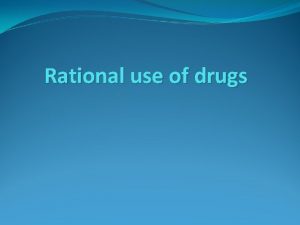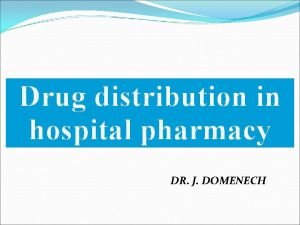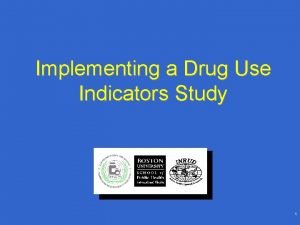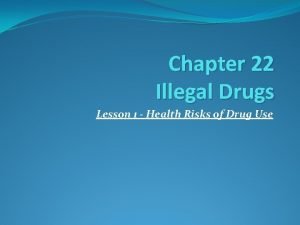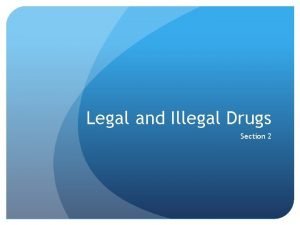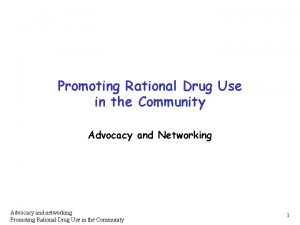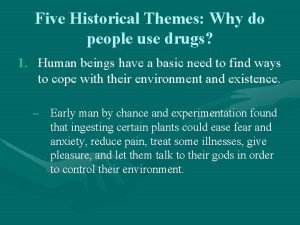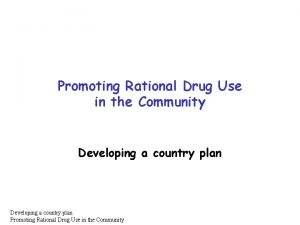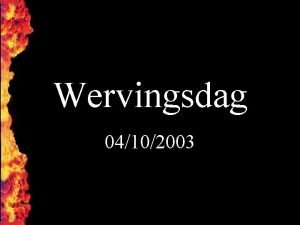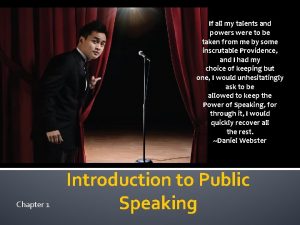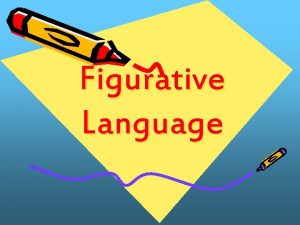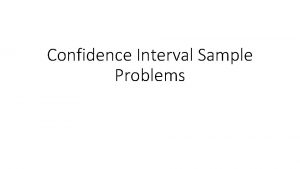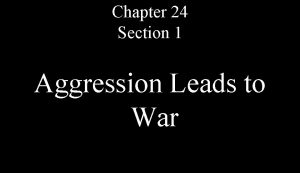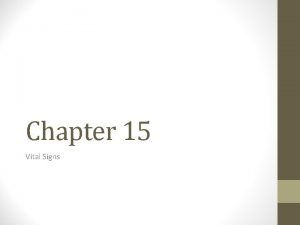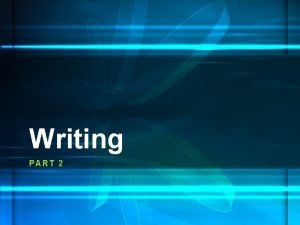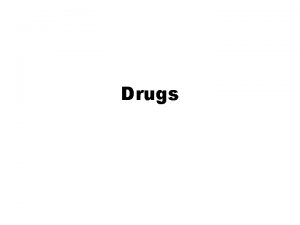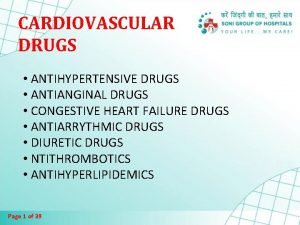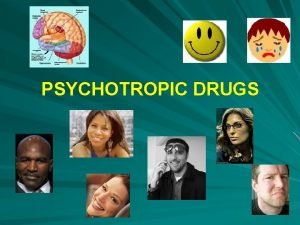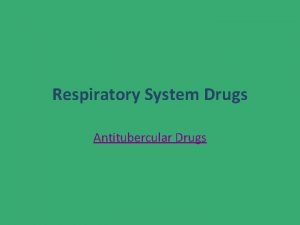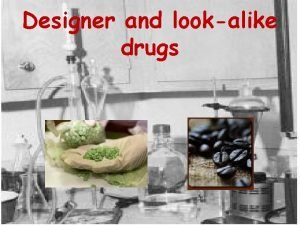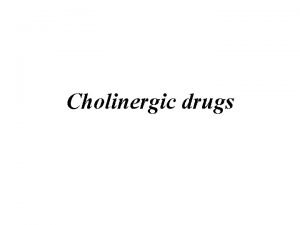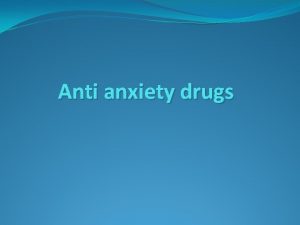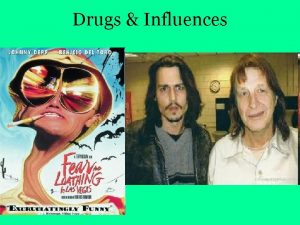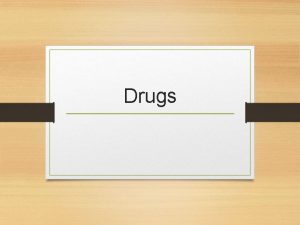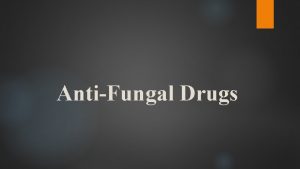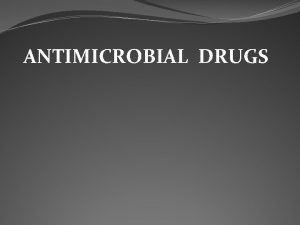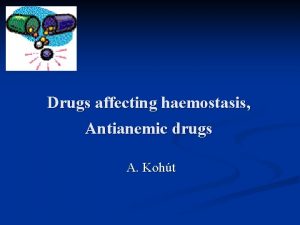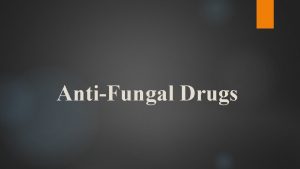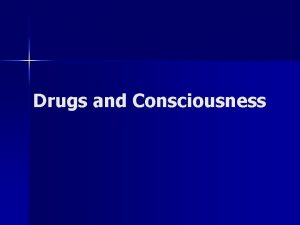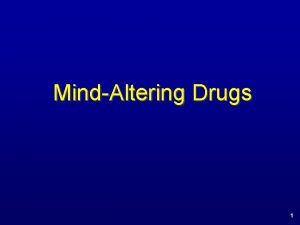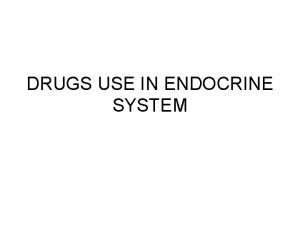Drug Unit Drug Use Drug Use Drugs taken
































- Slides: 32

Drug Unit

Drug Use • Drug Use – Drugs taken as directed to treat illnesses. (Ex. prescriptions and non-prescription drugs. ) • Drug Misuse – The improper use of drugs, when taken not as directed. – Taking more than the prescribed amount – Taking with the wrong foods or at the wrong time of day – Not taking them for the correct period of time

• Drug Abuse – Intentional misuse of any kind of drug for non-medical purposes. • Drug – any chemical that causes a change in a person’s body or behavior. Directly affects the Central Nervous System. • CNS – consists of your brain and spinal cord, coordinates your thoughts, actions and body functions.

Effects of Drugs of Abuse on the Brain • Pleasure, which scientists call reward, is a powerful biological force for our survival. • Dopamine – a chemical neurotransmitter, release messages about pleasure, through nerve fibers to nerve cells. • All drugs that are addicting, activate the brain’s pleasure circuit, by affecting chemical neurotransmission.

• • Examples Heroin and LSD, mimic the effects of a natural neurotransmitter. PCP, block receptors and prevent neuronal messages from getting through. Cocaine interferes with the molecules that are responsible for transporting neurotransmitters back into the neurons. Methamphetamine causes neurotransmitters to be released in greater amounts than normal.

Drug Interactions • Side Effects – reactions to medicine other than intended. • Additive Interaction – When medicines work together in a positive way. • Synergistic Effect – The interaction of two or more drugs that result in a greater effect then when the drugs are taken independently, which can lead to life threatening situations. • Antagonistic Effect - When the effect of a drug is canceled or reduced when taken with another. Which can also lead to life threatening situations. Ex. Stimulant/depressant

1. STIMULANTS – Speed up the CNS. – Cause an increase in heart rate, respiratory rate, blood pressure, dilated pupils and decrease appetite. – Inhalation or injection cause a sudden increase of blood pressure that will result in stroke, high fever, or heart failure. – Psychological effects include, moodiness, restlessness, anxiety, hallucinations, delusions and paranoia.

Examples of Stimulants • Amphetamines – Colorless, volatile liquid – illegally used to stay awake and alert, to improve athletic performance, to lose weight, or offset the effects of depressants. – Medically used to treat ADHD, depression and narcolepsy.

Methamphetamines • White, crystalline form of amphetamine. • Medically used to treat Parkinson's and obesity • Illegal use called crank, ice or speed. Can be smoked, snorted, injected or swallowed and can cause paranoia and violence.



Cocaine • White powder which is a rapid acting, powerful stimulant. Effects can last from 20 minutes to several hours, followed by a tremendous crash. • Will cause depression, weight loss, physiological dependence, tissue damage in the nose, malnutrition and an increased risk of heart attack. • Crack is the smoked form which effects are felt in seconds. Extremely addictive and dangerous.

Depressants • Slow down CNS. Reduce heart rate, breathing rate and blood pressure. Relax muscles, relieve tension and bring on sleep. • Alcohol is the most commonly used depressant. • Cause psychological and physical dependence.

Barbiturates • Induce sleep, result in mood changes, abnormal sleep and coma. • Rarely used for medical purposes. • Used illegally to cause feeling of intoxication and counteract the effects of stimulants. • If used with alcohol, the decrease in heart rate can lead to death.

Tranquilizer • Reduce muscle activity, coordination and attention span • Can be used medically (diazepam) to relieve muscle spasm, anxiety and nervousness.

Methaqualone • Originally prescribed to reduce anxiety and help with insomnia. Tasteless and odorless. • Produces temporary feelings of euphoria and withdrawal from is extremely unpleasant. • Serious effects include rapid dependence, headaches, diarrhea, dizziness, convulsions and coma.

Narcotics • Derived from the opium plant that have a sedative effect • Can result in psychological dependence. • Also include medicines to relieve pain. • Can cause stupor or sleep so deep to repress respiration and result in coma or death.

Examples of Narcotics • Morphine • A natural narcotic compound. • Sometimes used to relieve pain for ex. in a terminal cancer patient. • Causes severe constipation and leads to addiction.

• Codeine • A weaker form of morphine, often used in cough medicines. • Considered the most widely used opiate in the world. • Can lead to dependence and abuse

Heroin • Made from morphine and has no medical use. • Extremely addictive and rapid acting because it quickly passes the blood-brain barrier. • Tolerance develops quickly and withdrawal is painful usually beginning 6 -8 hrs. after the use of heroin. • Pain, anxiety, itching, muscle spasms and insomnia. • The purity of heroin is now 15 times higher than in the 1980’s.

Hallucinogens • Drugs that alter moods, thoughts, and sense perceptions, including vision, hearing, smell and touch. • Considered to be the most dangerous category because of the life threatening acts it causes people to attempt. • Deaths are caused by strange, destructive behavior that the drug produces in the user.

Phencyclidine (PCP, Angeldust) • Powerful hallucinogen in which muscle coordination is impaired, and the sensations of touch and pain are extremely dulled. • Can make the user feel strong and powerful, which can result in tragic deaths, serious accidents, and terrible acts of violence

Lysergic Acid Diethylamide (LSD, Acid) • One of the most mood altering chemicals with wildly unpredictable effects. • Takes the form of capsule, tablet and liquid. • Causes a false sense of security and power which result in death. • Hallucinations lead to panic, anxiety or accidental suicide.

Mescaline • Psychoactive ingredient of the peyote cactus. • This drug leads to “bad trips” or frightening imagined phenomena and can lead to vicious stomach cramps and vomiting.

Designer Drugs Ecstasy (MDMA) (Methylenedioxymethamphetamine) – A synthetic psychoactive drug with both stimulant and Hallucinogenic properties. – MDMA in high does causes sharp increase in body temp. Leading to muscle breakdown and kidney failure. – May also lead to heart attacks, strokes, and seizures.

Health Risks • Psychological Problems – Depression – Sleep problems – Severe anxiety and paranoia • Physical Problems – Involuntary teeth clenching – Increased heart rate – Sweating and chills

• Long term effects – Damage to those parts of the brain critical to thought and memory – Destroys serotonin producing neurons in the brain – Destroys neurons containing the neurotransmitter dopamine.

Ketamine • Ketamine – is an injectable anesthetic that has been approved for both human and animal use in medical settings. – 90% of all Ketamine legally sold today is intended for veterinary use. – Reactions similar to those associated with the use of PCP – Produced in liquid form or as a white powder that is often snorted or smoked with marijuana or tobacco products – Delirium, amnesia, impaired motor function High blood pressure, and potentially fatal respiratory problems

Rohyphol • Belongs to the class known as benzodiazepines – Valium, Xanax – Not approved for prescription in the US – Approved in Europe for treatment of insomnia, as a sedative and pre surgery anesthetic. – Tasteless, colorless, and odorless, it dissolves easily in carbonated drinks

• The sedative and toxic effects or Rohypnol are stronger with use of alcohol • Even without alcohol, a dose of Rohypnol as small a 1 mg can impair a victim for 8 to 12 hours • The drug can cause amnesia • The drug is used in sexual assaults (Date Rape Drug) • http: //www. youtube. com/watch? v=2 udrpu. Nxcm. M&feature=related

GHB • Gamma-Hydroxybutyrate – Produced in clear liquid, white powder, tablet and capsule – Often used in combination with alcohol making it even more dangerous – CNS depressant – Effects happen 10 -20 minutes after taking it – Last up to 4 hours – Colorless, odorless, and has a slightly salty taste

• Short term effects – Nausea – Difficulty breathing – Produces withdrawal effects • Long term effects – Coma or death (as the dose increases)
 Unit 6 review questions
Unit 6 review questions Importance of rational drug use
Importance of rational drug use Methods of adulteration of crude drugs
Methods of adulteration of crude drugs Basket system of distribution of medicines
Basket system of distribution of medicines Centralized drug distribution
Centralized drug distribution Drug use indicators definition
Drug use indicators definition Chapter 22 illegal drugs lesson 1 worksheet answers
Chapter 22 illegal drugs lesson 1 worksheet answers The extra dopamine released during drug use can *
The extra dopamine released during drug use can * International standards on drug use prevention
International standards on drug use prevention Objectives of rational drug use
Objectives of rational drug use Themes about drugs
Themes about drugs Objectives of rational drug use
Objectives of rational drug use When and where was this photograph taken?
When and where was this photograph taken? 22 taken van de brandweer
22 taken van de brandweer If past perfect would have past participle
If past perfect would have past participle The road not taken theme
The road not taken theme Explanation the road not taken
Explanation the road not taken The road not taken connotation
The road not taken connotation The road not taken figurative language
The road not taken figurative language Swana physical features
Swana physical features Where is apical pulse
Where is apical pulse Rhyme of the road not taken
Rhyme of the road not taken If all my talents and powers to be taken
If all my talents and powers to be taken Www.youtube.com
Www.youtube.com A comparison of two unlike things using like or as
A comparison of two unlike things using like or as Crack” went the bat as the pitcher hit a home run.
Crack” went the bat as the pitcher hit a home run. A random sample of 12 shearing pins is taken
A random sample of 12 shearing pins is taken Francisco franco aggressive actions
Francisco franco aggressive actions Chapter 15:1 measuring and recording vital signs
Chapter 15:1 measuring and recording vital signs Bridging the road not taken
Bridging the road not taken Cash discounts are not taken on freight or returned goods
Cash discounts are not taken on freight or returned goods Four types of writing
Four types of writing Stalin
Stalin

